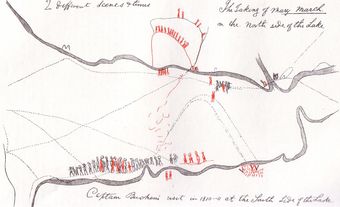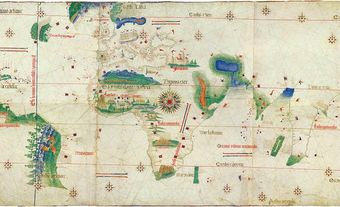The Second World War can be considered a turning point in Canadian topographic mapping. Before the war, topographers used plane tables and sketched out small sections of the terrain that were subsequently joined together into a map. This method was slow, not very accurate and unusable in forested areas. Aerial photographs were used, but in the whole country only one instrument plotted map detail directly from air photos. Advances in mapping following the Second World War include photogrammetry, the Air Profile Recorder, the Doppler Positioning System, and the Global Positioning System. (See also History of Cartography in Canada; Cartography in Canada: 1763-Second World War.)
Photogrammetry
During the Second World War, the staff of Canada’s military mapping units became familiar with European photomapping equipment. They became a postwar source of trained technicians available for the modernization of Canada’s mapping agencies. The introduction of photogrammetry — the drawing of maps from aerial photographs — was only one of many technological innovations that transformed every phase of topographic mapping in Canada.
Air Profile Recorder
Shortly after the Second World War, a Canadian invention, the Air Profile Recorder (APR), provided a method for contouring small and medium-scale maps of the Canadian North. (During the war, Canadian aeronautical charts of Northern Canada were actually published without contours. This was because the charts were needed for supply flights to Britain and the USSR and no method was available to provide height information.) Today, an air chart without precise height information is unthinkable, and APR was the answer to this wartime problem.
The APR is a radar device that measures and records the vertical distance down to the ground beneath a plane flying at a known altitude. The track of the APR plane is recorded by a downward looking 35 mm camera, and the profile of the ground is continuously plotted on paper tape. In this way, elevations needed for contouring Canada’s northern air charts were obtained. APR was used around the world by many countries, but today it has been superseded by more accurate methods.
Doppler Positioning System
Each phase of the mapping process has its own instrumentation, almost all of which has been developed since the 1970s. The most dramatic advances have been in satellite surveying. The “space age” began in 1957 when the Russians launched the first Sputnik satellite. Within 15 years, the US navy had developed a navigation system based on the reception of radio signal from passing satellites. From these signals, the latitude and longitude of a ship could be calculated with great accuracy.
The method of observation consisted of recording radio signals from satellites passing in the sky approximately 1,000 km above Earth. The Doppler shift (the apparent change in frequency of the satellite’s radio signal as it passes overhead) was noted. The rate of change of the frequency shift is a function of the ship’s distance from the satellite. As the position of the satellite is known at all times by independent tracking from known positions around the world, the ship’s position can be calculated to an accuracy of about 10 m. This was far too precise for navigation needs but was ideal for the horizontal control of the 1:50,000 mapping being done in Northern Canada.
Global Positioning System
Despite its great usefulness, Doppler Positioning System lasted less than 20 years. It was overtaken by another American development, the Global Positioning System (GPS). This is also a satellite system in which 24 satellites have been placed in near-circular orbits approximately 20,000 km above Earth.
A small portable receiver on the ground receives signals from the three or four satellites that are above the horizon at any time. The distance to each of the satellites at any instant can be computed by the receiver. This is done by electronically timing the passage of the signal from satellite to receiver. With this information, a computer, built into the receiver, can calculate its position. As with the DPS, the positions of the satellites are precisely known at all times by independent tracking, and hence the latitude and longitude of the receiver can be obtained.

 Share on Facebook
Share on Facebook Share on X
Share on X Share by Email
Share by Email Share on Google Classroom
Share on Google Classroom



